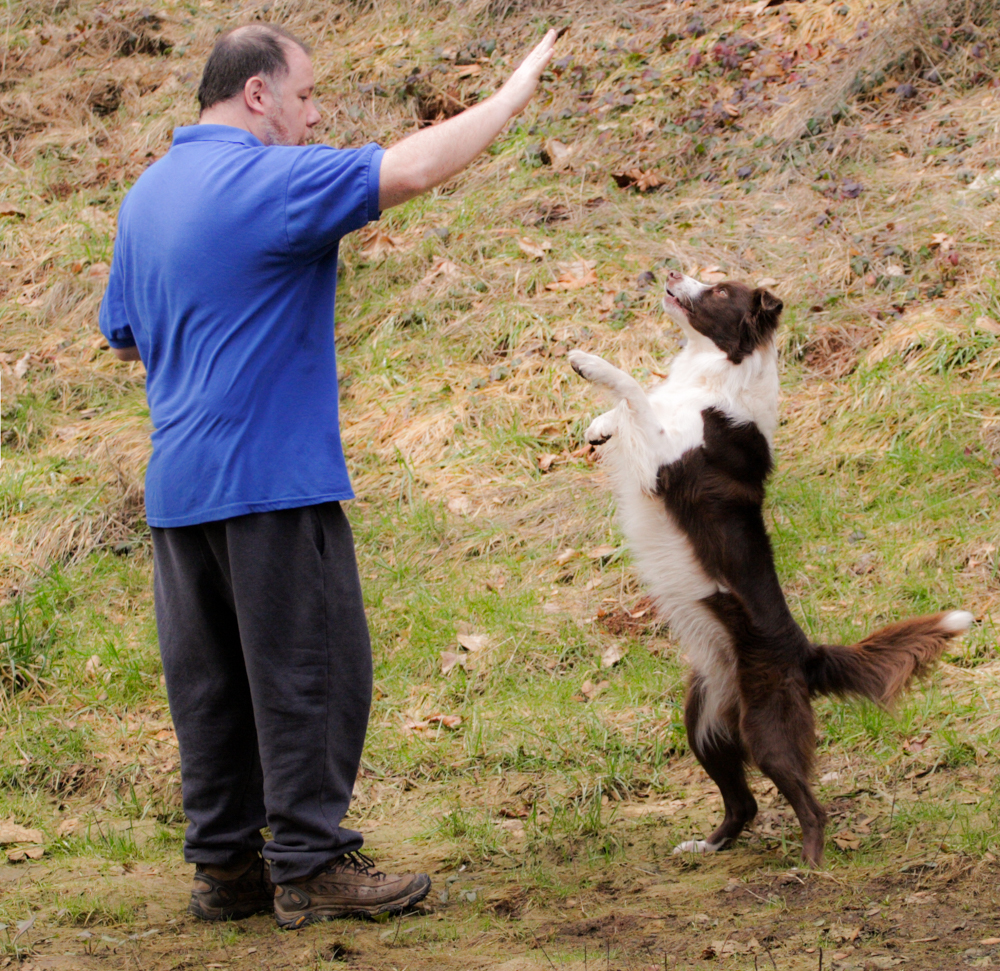I found myself watching a novice obedience class a few nights ago, and I wanted to cry. Don’t get me wrong, nothing awful was happening, no physical abuse, no harsh corrections, but so little joy… Watching most people plod along with their dogs connected to them by a leash but nothing else is like some macabre satire of what dog training ought to be.
If you watch 20 people train their dogs, you will immediately observe that there are two distinct groups who are essentially doing two completely different things: those who are going through the motions but their dogs are disconnected, flat, out of control. And those whose dogs are beautifully, magically, joyfully playing the game. Within each group you will see a variety of techniques and skill levels, the difference between them is something more fundamental…
Here is the secret that separates the two groups:
You cannot effectively teach your dog anything until you get him engaged and connected. Attentive, happy, excited, eager to learn, enthused. You need to make learning enjoyable. You must figure out what makes your dog excited and build an expectation that playing/training together is super fun. One of your very first responsibilities as an owner and trainer is to figure out how to induce joy for your pet, what combination of treats and toys and tone and luring and whacking and squealing and petting really lights them up; and if you cannot figure out a path to joy, you need to build one. You need a great attitude yourself. You need to make sessions short and fast. You need to tug and fetch and race and wrestle and play. You need to be willing to get on the floor, to run, to praise and cheer like a loon. You need to play with your dog many times each day at home and everywhere so that you have built this into your relationship. You need to teach your dog that looking at you is great, on its own, and that it is the key that will unlock the best and most rewarding game of all. Only when you have built this reward base and tapped into attention and attitude can you really start worrying much about specific behaviors, and you will find they are so much easier to train when you and your dog have this core connection.
If you are dragging your dog around, pushing and pulling him into various positions, giving him commands that he ignores, you are not merely wasting your time, you are actually hurting your relationship. You are making your dog like you less. You are convincing your dog that you are a boring bully. You are inculcating resistance, lethargy, disinterest. Better to NOT train your dog than to keep slogging through these miserable sessions. Stop training immediately, and from now on any time you feel yourself starting to do this, stop! Go do something else. Come back when you are ready to be present, joyous, enthused, connected.
If you can get five beautiful seconds of your dog looking at you, ears perked and eyes bright, listening, eagerly trying to play the game with you, then you are genuinely training your dog. Tomorrow it will be ten seconds, then twenty… Now you have a partner, you can start dancing, start working on super-fast sits followed by a game. A step or two of perfect heeling, an eager down. Happy, happy chase recalls. Now you are working for several perfect minutes, increasing distance, duration, distraction, but never for a moment sacrificing attitude and relationship… Do this for a few months, and you will be amazed! You will have a dog that loves training with you, that has a fabulous attitude, and that can do all those behaviors you originally wanted.


Great post. So true that you have to engage your dog before even trying to teach them anything. I work with pet owners, and find that most people *want* to engage and have fun with their dog, and they get excited when I show them how 🙂 The problem with most obedience classes is that they focus only on the behaviour, not on the relationship between the owner and the dog. I think times are changing though, there is an increasing focus on engagement and relationship building.
Thanks for sharing 🙂
The domestic dog (Canis lupus familiaris or Canis familiaris) is a domesticated canid which has been selectively bred for millennia for various behaviors, sensory capabilities, and physical attributes
A trainer of a group class once challenged us to a tail wag contest. She promised a desirable book to the owner of the dog who wagged the most. But she instructed us not to talk. You would think this would be easy but it truly exposed those two groups you describe. Those who can get their dogs to wag by saying things they don’t mean (how rude!) or those who know what their dogs actually like. The guy who won? Got down on all fours. His dog loved it and he deserved the prize. We all learned a great deal that session, though. Nice post about being the guy who knew his dog best.
[…] The Secret of Dog Training […]
Figure out how to listen to your pooch. On the off chance that your pooch seems, by all accounts, to be uncomfortable meeting another puppy, creature or individual, don’t demand that he make proper acquaintance. He’s letting you know that he isn’t happy for a reason, and you ought to regard that. Driving the issue can regularly bring about more serious issues down the line.
Dogs always communicate using body language, so understanding your dog’s body language can help interpret the dog’s intentions.
[…] Original: http://talentedanimals.com/blog/the-secret-of-dog-training/ […]